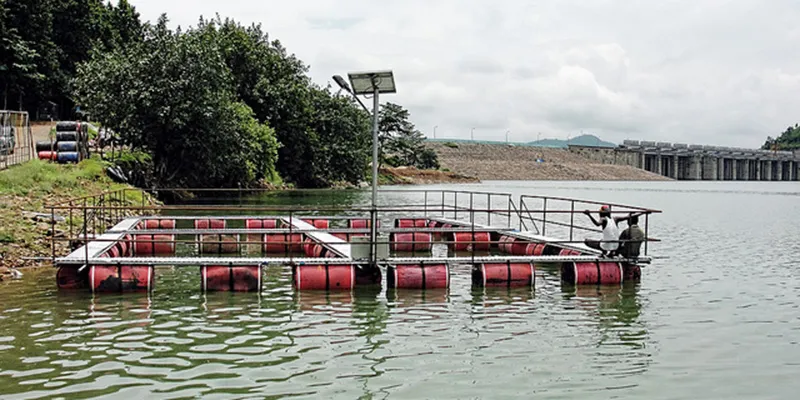In Jharkhand: When farmer lost their land to a dam, 2,000 of them took up fishing—in cages
The rush for caged fish culture of one variety has created a glut in the market, which has led to the crashing of prices. How will the farmer-fishermen cope?
The Chandil dam reservoir is located 30 km from Jamshedpur on the Subernarekha river in Jharkhand. While this dam is a 'tourist hotspot', its construction has resulted in the displacement of more than 20,000 families from 116 surrounding villages. “We lost our farmlands because of the project and now, to support our families, we have to take any job available," says Narayan Gope.

In 2007, the Jharkhand government initiated a project to help address the problem of displacement—the 'cage fish farming project'. This pilot project was funded by the National Mission for Protein Supplement Scheme. The goal of this initiative was two-fold: to fulfil the protein requirements of the people at a low cost and to create livelihood opportunities for the displaced farmers.
In 2011, the government provided a 100 percent subsidy to Chandil Bandh Visthapit Matsyajibi Swabalambi Sahakari Samiti (CBVMSSS), the fishing cooperative of the displaced farmers, to buy 70 cages for cage fish farming. They further provided 126 modular cages to CBVMSSS with a 90 percent subsidy in 2013. The state Fisheries Department provided the technical support and training to the CBVMSSS so that the farmers would get the required knowledge to manage and run these fish farms.
What is cage fish farming?
It is a method of nurturing small fish in modular iron cages that are 6 x 4 x 4 metres in dimension. These water-resistant cages float in the water bodies surrounded by nylon nets to hold the fish within. Needing very little maintenance, these cages cost around Rs 2.5 to 3 lakh.

What type of fish can be reared?
The fish cultured in the Chandil reservoir belongs to a variety called Pangasius. This is a type of catfish which is native to Vietnam, Cambodia, and Thailand. Its speciality is that in six months’ time, its weight increases to 1 kg. The cost of production for 1 kg of Pangasius is Rs 35-40 and the selling price is Rs 70-80. For Indian conditions, this variety of fish is good for cultivation in open aquaculture ponds or in dam reservoirs. The fish is cheap, high in demand, easy to cultivate and can yield high profits in a short span of time. The production of fish in one cage varies from four to five tons every six months. The average fish produced from 2011 to 2013 was 134.33 tons and the net income of CBVMSSS in 2012-13 was around Rs 25 lakh.
Problems with this plan
Only 2,000 of the 20,000 displaced families took to this type of fishing as their primary occupation. The remaining 18,000 families could not cope with it and hence migrated to nearby places as labourers. But Shyamal Mardi, another displaced farmer, says, “The initiative of cage fish farming has solved the livelihood problems of the displaced to some extent. The workers working with the fishing cooperative are quite happy about their progress. They don't want to shift to any other job”.
It's hard to tell whether he truly believes his words or if he is saying it out of a lack of option.
The other problem with this initiative is the lack of a regulatory body to keep the fish production in check. "In 2011, the haphazard growth of Pangasius fish culture in Andhra Pradesh, led to a price crash resulting in losses for growers of this fish", says V. Vasudevappa, a senior executive of the National Fisheries Development Board (NFBD).

In the last two decades, there has been a sharp decline of local varieties of fish like sol, bata, bada tengra and others due to pollution in the Subarnarekha river. So, the larger concern is the sustainability of the production of Pangasius. Also, if the demand is not constant throughout the year, the risk has to be borne by the fish producers. Without regulating fish production, it is difficult to attain economic stability in the long run.
Has cage fish culture worked at Chandil?
It's not a very clear answer just yet. The temporary improvement in the income of 2,000 displaced families is a matter of relief for the government but generating employment for the 18,000 that are still displaced is a big challenge.
If a person's livelihood is taken away, efforts must be made to replace it in the same, if not a similar form.
Disclaimer: This article, authored by Makarand Purohit, was first published in India Water Portal.







